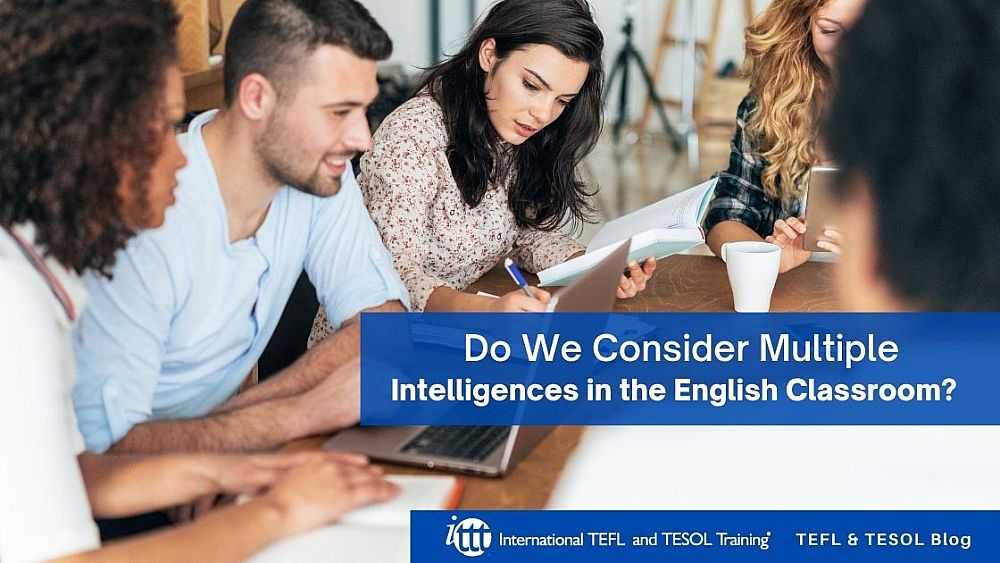Do We Consider Multiple Intelligences in the English Classroom?

"Every human being has a unique combination of intelligence. This is the educational challenge fundamental". - Howard Gardner.
Table of Contents
Check out what our course grads say in our many video testimonials!
Gardner was an American developmental psychologist whose theory claims that the person possesses innate intellectual capacities that allow them to build their own knowledge, according to their needs and interests. Gardner classified them as intelligences and according to his theory, the traditional terms were: Verbal / Linguistic, Logical / Mathematical, Spatial / Visual, Bodily / Kinesthetic, Musical / Rhythmic, Naturalistic or Nature smart, Interpersonal and Intrapersonal.
It is better to think of these Multiple intelligences as abilities or strengths. The human brain is very complex and all of these types of "smarts" work together to perfection. Moreover, each person may have several of these strengths, not just one. The kid-friendly version of the MI terms are: Word, Art, Math, Music, Body, People, Self and Nature SMART.
The Theories of Multiple Intelligences (MI) offers a broader understanding of the human being and the different ways he or she has to learn and manifest his or her intellectual and social knowledge. One of the major challenges for teachers of English abroad involves engaging a classroom full of students who are on different learning levels, have different learning abilities and who all learn in different ways.
In teaching English as a foreign language, not only intrinsic stimuli are important, extrinsic stimuli also play a relevant role in the success of the language teaching-learning process, hence the implementation of the theory of Multiple Intelligences help both the teacher and the student to achieve the goals inside the Classroom.
The Multiple Intelligences' Theory helps design activities that motivate students. MI is key in the inclusion of all the talents that people have as a vehicle to achieve their different and individual learning goals. Students learn best when they are able to engage in activities that take advantage of their strengths.
In addition to the many benefits, students develop relevant skills according to their abilities and interests, which motivates them to discover their own knowledge and thus improve the teaching and learning process.
Teachers also benefit from Gardner's theory since lesson planning with a focus on Multiple Intelligence theory brings more variety into the Classroom creating a fun learning environment. It is known that a fun, diverse and engaging learning atmosphere helps develop better social communication skills and improves the learning.
Here are some fun and engaging ideas to include individual Multiple Intelligences in an English language classroom:
- Verbal or Word smart: word games aimed at enriching and activating vocabulary, memorizing new words in different ways, fun dialogues, discussions, stories, jokes that incorporate new use of language expressions.
- Logical or Math smart: word order in a sentence, logical games, solving logical problems.
- Visual or Picture smart: art projects, visual presentations, VR virtual reality or video projects, creating maps and giving directions.
- Musical or Rhythmic smart: songs that incorporate new words or relevant grammar points, musical presentations, social media clips.
- Kinesthetic or Body smart: active games, TPR, choreography, yoga, social media clips.
- Naturalistic or Nature smart: guided meditation in slow English or TPR games out in nature, art projects that incorporate interacting with plants and animals.
- Interpersonal or People smart: discussion, research, exchange of opinions, group projects, let the chatty students teach the class, or use technology to have them interact with others via Skype or chat.
- Intrapersonal or Self smart: genealogy project, a description of places where students feel free and happy, self-correction, writing poems and stories, expressing personal opinions, blogs, journals, and essays on personal topics.
No matter which method is most effective for a student to learn, the more MI that lesson planning can engage, the more chances a student has of mastering the material, and the more chances teachers have of leading their students to achieve their learning goals.
Using the MI approach, an English teacher can provide opportunities for authentic learning based on each individual learner.There are many tests online available to assess MI that provide spectacular insight to identify each student's individual way of learning.
In summary, the development of language teaching through the application of MI theory offers students the possibility to use their own ways of being "smart" in favor of better performance in the foreign language.
Apply now & get certified to teach english abroad!
Speak with an ITTT advisor today to put together your personal plan for teaching English abroad!
Send us an email or call us toll-free at 1-800-490-0531 to speak with an ITTT advisor today.
Related Articles:
- Top 10 Cities in Europe with the Highest Demand for English Language Teachers
- 5 Reasons To Take A TEFL Course Right Now - Even If You Are Not Leaving Yet | ITTT | TEFL Blog
- All the Documents You Will Need to Teach English Abroad
- The Impact of Positive Motivation on an ESL Classroom
- You're Never Too Old to Change Your Life and Do a TEFL Course | ITTT | TEFL Blog
- Getting Student Placement Right - The Best Desk Arrangements for EFL Students



